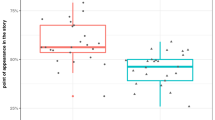Abstract
This paper presents an application that automatically generatesbasic stories: short texts that only narrate the main events of the plot. The system operates with a representation in Description Logics, combining stored fabulas with the narrative knowledge implemented in a domain-specific ontology. The domain of application is the traditional folk tale, using the well-known morphology of Vladimir Propp as narratological background. In order to evaluate the results, human judges blindly compared one of the generated basic stories to two alternatives: one rendered directly from a stored fabula of the knowledge base and another randomly generated. As a conclusion, possibilities of measuring the utility of the system in terms of quality and originality of the generated artifact are discussed.
Similar content being viewed by others
References
Baader, F., Calvanese, D., McGuinness, D. L., Nardi, D. and Patel-Schneider, P. F.,The Description Logic Handbook. Theory, Implementation and Applications, Cambridge University Press, UK, 2003.
Bechhofer, S., van Harmelen, F., Hendler, J. Horrocks, I., McGuinness, D. L., Patel-Schneider, P.F. and Stein, A.,OWL Web Ontology Language Reference, W3C, http://www.w3.org/TR/2004/REC-owl-ref-20040210/ [Last access: 16/1/2006]
Boden, M.A.,The Creative Mind: Myths and Mechanisms, Wedenfield and Nicholson Ltd., London, UK, 1990.
Chatman, S.,Story and Discourse: Narrative Structure in Fiction and Film (Second Edition), Cornell University Press, USA, 1986.
Crubézy, M., Dameron, O., Fergerson, R.W., Knublauch, H., Musen, M.A., Noy, N.F., Rubin, D., Tu, S.W. and Vendetti, J.,Protégé Project, Standford University, http://protege.stanford.edu/ [Last access: 16/1/2006]
Díaz-Agudo, B., González-Calero, P.A., “CBROnto: A Task/Method Ontology for CBR,”The 15th International FLAIRS 2002 Conference, (Special Track on Case-Based Reasoning), AAAI Press, 2002.
Díaz-Agudo, B., Gervás P. and González-Calero, P., “Poetry Generation in COLIBRI,” inProceedings of the 6th European Conference on Case Based Reasoning, Advances in Case Based Reasoning (Craw, S. and Preece, A., eds.),LNAI Springer-Verlag, 2002.
Díaz-Agudo, B. and Gervás, P. and Peinado, F., “A Case Based Reasoning Approach to Story Plot Generation,” inProceedings of the 7th European Conference on Case Based Reasoning. Advances in Case Based Reasoning (González-Calero, P.A. and Funk, P., eds.),LNAI, pp. 142–156, Springer-Verlag, 2004.
Fairclough, C. and Cunningham, P., “A Multiplayer Case Based Story Engine,” inProceedings of the 4th International Conference on Intelligent Games and Simulation, EUROSIS, pp. 41–46, 2003.
Gervás, P., Díaz-Agudo, B., Peinado, F. and Hervás, R., “Story Plot Generation based on CBR,” inProceedings of the 24th Annual International Conference of the British Computer Society’s Specialist Group on Artificial Intelligence. Applications and Innovations in Intelligent Systems XII (Macintosh, A., Ellis, R., and Allen, T., eds.), Springer WICS series, pp. 33–46, 2004.
Hewlett-Packard,Jena: A Semantic Web Framework for Java, Sourceforge, http://jena.sourceforge.net/ [Last access: 16/1/2006]
Klein, S., Aeschliman, J.F., Balsiger, D.F., Converse, S.L., Court, C., Forster, M., Lao, R., Oakley, J. and Smith, J., “Automatic Novel Writing: A Status Report,”Technical Report 186, Computer Science Department, University of Wisconsin, USA, 1973.
Lang, R.R.,A Formal Model for Simple Narratives, Tulane University, 1997.
Malec, S.A.,Proppian Structural Analysis and XML Modeling, http://clover.slavic. pitt.edu./ŝam/propp/theory/propp.html [Last access: 16/1/2006]
Meehan, James R., “TALE-SPIN and Micro TALE-SPIN,”Inside Computer Understanding (Schank, Roger C. and Riesbeck, Christopher K., eds.), Lawrence Erlbaum Associates, Hillsdale, NJ, USA, 1981.
Meister, J.C., Lönneker, B., Krause, R. and Thiedig, S.,Story Generator Algorithms Project, Narratology Research Group, Faculty 07 SLM, University of Hamburg, http://www.rrz.uni-hamburg.de/story-generators/index_en.html [Last access: 16/1/2006]
Mindswap,Pellet OWL Reasoner, Mindswap, http://www.mindswap.org/2003/pellet/index.shtml [Last access: 16/1/2006]
Pérez y Pérez, R. and Sharples, M., “MEXICA: A Computer Model of a Cognitive Account of Creative Writing,”Journal of Experimental and Theoretical Artificial Intelligence, 13, 2, pp. 119–139, 2001.
Propp, V.,Morphology of the Folktale, University of Texas Press, USA, 1968.
Riedl, M.O. and Young, R.M., “Story Planning as Exploratory Creativity: Techniques for Expanding the Narrative Search Space,”Proceedings of the A International Joint Conference on Artificial Intelligence, Workshop on Computational Creativity, Edinburgh, UK, 2005.
Ritchie, G.D., “Assessing Creativity,”Proceedings of the AISB Symposium on Artificial Intelligence and Creativity in Arts and Science (Wiggins, G., ed.),LNAI, pp. 3–11, Springer-Verlag, 2001.
Seifert, L., Lim, C., Tan, L. and Wee, N.,Digital Propp: Proppian Fairy Tale Generator, Brown University, http://www.brown.edu/Courses/FR0133/Fairytale_Generator/ [Last access: 16/1/2006]
Sgouros, N.M., “Dynamic Generation, Management and Resolution of Interactive Plots,”Artificial Intelligence, 107, 1, pp. 29–62, 1999.
Turner, S.R., “Minstrel: A Computer Model of Creativity and Storytelling,”Technical report UCLA-AI-92-04, Computer Science Department, University of California, USA, 1992.
Author information
Authors and Affiliations
Corresponding author
Additional information
Federico Peinado: He is a Teaching Assistant at Universidad Complutense de Madrid, Spain. He received his B.S. and M. Phil. in Computer Engineering from the UCM in 2002 & 2004. His research is focused on Computational Narratology, Game Design and the applications of Artificial Intelligence and Computational Creativity to humanistic domains.
Pablo Gervás, Ph.D.: He is Associate Professor at Universidad Complutense de Madrid, Spain. He received his B.S. from the Universidad Complutense de Madrid in 1990 and his Ph.D. from Imperial College London in 1995. He has contributed research results in information retrieval, natural language generation, casebased reasoning and computational creativity.
About this article
Cite this article
Peinado, F., Gervás, P. Evaluation of automatic generation of basic stories. New Gener Comput 24, 289–302 (2006). https://doi.org/10.1007/BF03037336
Received:
Revised:
Published:
Issue Date:
DOI: https://doi.org/10.1007/BF03037336




